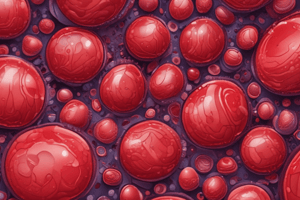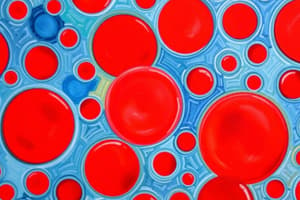Podcast
Questions and Answers
Match the following factors with their roles in red blood cell lifespan:
Match the following factors with their roles in red blood cell lifespan:
Iron = Key to oxygen transport Vitamin B12 = Required for DNA synthesis Folates = Essential for red cell proliferation EPO = Stimulates red blood cell production in response to hypoxia
Match the following globin chain disorders with their characteristics:
Match the following globin chain disorders with their characteristics:
Sickle Cell Disease = Abnormal hemoglobin structure Alpha Thalassemia = Deficiency in alpha globin chains Beta Thalassemia = Deficiency in beta globin chains Hemoglobin C Disease = Causes mild hemolytic anemia
Match the inheritance patterns with the blood disorders they are associated with:
Match the inheritance patterns with the blood disorders they are associated with:
Sickle Cell Disease = Autosomal recessive Hemophilia = X-linked recessive Beta Thalassemia = Autosomal codominant G6PD Deficiency = X-linked recessive
Match the following erythropoiesis mechanisms with their descriptions:
Match the following erythropoiesis mechanisms with their descriptions:
Match the impacts of iron deficiency with their effects on red blood cells:
Match the impacts of iron deficiency with their effects on red blood cells:
Match the following aspects of red blood cells with their descriptions:
Match the following aspects of red blood cells with their descriptions:
Match the globin chain disorders to their characteristics:
Match the globin chain disorders to their characteristics:
Match the blood disorder inheritance patterns:
Match the blood disorder inheritance patterns:
Match the mechanisms involved in erythropoiesis:
Match the mechanisms involved in erythropoiesis:
Match the factors affecting hemoglobin-oxygen dissociation:
Match the factors affecting hemoglobin-oxygen dissociation:
Match the impacts of iron deficiency on red blood cells:
Match the impacts of iron deficiency on red blood cells:
Match the components of hemoglobin to their functions:
Match the components of hemoglobin to their functions:
Match the stages of oxygen transport by red blood cells:
Match the stages of oxygen transport by red blood cells:
Match the following red blood cell lifespan issues with their descriptions:
Match the following red blood cell lifespan issues with their descriptions:
Match the following globin chain disorders with their characteristics:
Match the following globin chain disorders with their characteristics:
Match the following causes of inheritance of blood disorders with their explanations:
Match the following causes of inheritance of blood disorders with their explanations:
Match the following erythropoiesis mechanisms with their functions:
Match the following erythropoiesis mechanisms with their functions:
Match the following impacts of iron deficiency with their consequences:
Match the following impacts of iron deficiency with their consequences:
Match the following factors affecting red blood cell health with their outcomes:
Match the following factors affecting red blood cell health with their outcomes:
Match the following features of sickle cell disease with their effects:
Match the following features of sickle cell disease with their effects:
Match the following treatments for red blood cell disorders with their aims:
Match the following treatments for red blood cell disorders with their aims:
Match the following types of hemolysis with their causes:
Match the following types of hemolysis with their causes:
Match the following indicators of red blood cell disorders with their meanings:
Match the following indicators of red blood cell disorders with their meanings:
Flashcards
Thalassemia
Thalassemia
Genetic conditions affecting red blood cell production.
Red blood cell function
Red blood cell function
Dependent on components like iron, B12, and folate.
Iron deficiency
Iron deficiency
Reduced iron impairs haemoglobin, leading to smaller, paler red blood cells.
EPO production
EPO production
Signup and view all the flashcards
Red cell dysfunction causes
Red cell dysfunction causes
Signup and view all the flashcards
Hereditary Spherocytosis
Hereditary Spherocytosis
Signup and view all the flashcards
G6PD Deficiency
G6PD Deficiency
Signup and view all the flashcards
Sickle Cell Anemia
Sickle Cell Anemia
Signup and view all the flashcards
Immune Mediated Hemolysis
Immune Mediated Hemolysis
Signup and view all the flashcards
Red Cell Breakdown
Red Cell Breakdown
Signup and view all the flashcards
Cell Extrinsic Factors
Cell Extrinsic Factors
Signup and view all the flashcards
Haemoglobin Variants
Haemoglobin Variants
Signup and view all the flashcards
Blood Transfusion
Blood Transfusion
Signup and view all the flashcards
Iron Deficiency Anemia
Iron Deficiency Anemia
Signup and view all the flashcards
Cell Intrinsic Issues
Cell Intrinsic Issues
Signup and view all the flashcards
Red Blood Cell Function
Red Blood Cell Function
Signup and view all the flashcards
Hemoglobin's Role in Oxygen Transport
Hemoglobin's Role in Oxygen Transport
Signup and view all the flashcards
Hemoglobin Structure
Hemoglobin Structure
Signup and view all the flashcards
Oxygen Binding to Hemoglobin
Oxygen Binding to Hemoglobin
Signup and view all the flashcards
Factors Affecting Oxygen Dissociation Curve (Shift)
Factors Affecting Oxygen Dissociation Curve (Shift)
Signup and view all the flashcards
Oxygen Delivery in Tissues
Oxygen Delivery in Tissues
Signup and view all the flashcards
2,3-DPG Effect
2,3-DPG Effect
Signup and view all the flashcards
Red Blood Cell Production Location
Red Blood Cell Production Location
Signup and view all the flashcards
Study Notes
Blood Composition
- Blood is composed of red blood cells (45%), white blood cells (1%), platelets (1%), and plasma (45%).
- Plasma also contains clotting factors, antibodies, electrolytes, and proteins.
- Plasma may also contain some dissolved oxygen.
Red Blood Cell Function
- Red blood cells transport oxygen to tissues and carbon dioxide away from tissues.
- They are flexible, bi-concave disks that allow them to pass through small capillaries.
- Haemoglobin within red blood cells increases the oxygen carrying capacity of blood (~70%).
- Clinically significant proteins in red blood cells include those that define blood type.
Red Blood Cell Structure
- Red blood cells lack a nucleus and mitochondria, increasing cell flexibility and reliance on glycolysis for energy.
- Their structure means they cannot regenerate.
- The spleen removes old red blood cells which have a limited life span.
Gas Transport
- Anaerobic respiration produces 2 ATP, while aerobic respiration produces 36 ATP.
- Efficient O2 delivery and CO2 removal support aerobic respiration and cellular energy production.
- Red blood cells produce energy through the Embden-Meyerhof pathway and the pentose phosphate pathway.
Oxygen Transport by Haemoglobin
- Haemoglobin significantly increases oxygen-carrying capacity (~70-fold).
- Haemoglobin is a combination of haem (iron bound to porphyrin ring) and globin (protein chains).
- Each haemoglobin A molecule contains two alpha and two beta globin chains.
- Other types of haemoglobin include HbA2 (2 alpha + 2 delta).
- HbF (foetal Hb) contains 2 alpha + 2 gamma chains.
Factors Affecting Haemoglobin-Oxygen Dissociation
- Temperature increases affect the dissociation curve, shifting it right (Decreased oxygen affinity).
- Higher metabolism leads to increased oxygen delivery.
- 2,3-DPG has a significant effect during pregnancy.
Red Blood Cell Production
- Red blood cells are produced in blood islands in the yolk sac, liver, and spleen, and mostly in the bone marrow after the 7th month of gestation.
- The production location changes over time based on age of development.
- Erythropoiesis, red cell production, begins from hematopoietic stem cells in the bone marrow.
- Erythropoietin controls red blood cell production.
Factors Affecting Red Cell Production
- Erythropoietin is mainly produced in the kidney and increases red blood cell production in response to anemia or hypoxemia.
- Availability of iron, B12 and folate is crucial for proper red blood cell production.
- Globin chain production is essential.
- Genetic disorders can cause deficiencies in red blood cell production.
Red Cell Function Problems
- Bone marrow failure can decrease the production of blood cells causing anemia.
- Problems with globin production cause thalassemia, where red blood cells lack one or more globin chains.
- A lack of B12 and folate needed for DNA synthesis during cell proliferation and production can lead to problems with cell production.
- Iron deficiency leads to decreased haemoglobin and smaller, paler red blood cells with low oxygen carrying capacity.
- Lack of stimulus, for example, impaired kidney function, leads to a loss of EPO production in response to hypoxia.
Cell Intrinsic Issues
- Red cell membrane defects lead to different red cell shapes (e.g., in hereditary spherocytosis) and increased red cell breakdown, due to damage identified by the spleen.
- Red cell enzyme production problems (e.g., G6PD deficiency) can increase red cell breakdown as well.
Cell Extrinsic Issues
- Red blood cell breakdown (haemolysis) occurs due to extrinsic factors such as the immune system attacking red blood cell components.
- Immune-mediated haemolysis involves the immune system inappropriately targeting red blood cells.
Anemia and Symptoms
- Anemia occurs due to reduced red blood cell production or increased red blood cell loss.
- Symptoms can include fatigue, dizziness, fainting, low blood pressure, palpitations, rapid heart rate, chest pain, and enlargement of the spleen.
Treatments
- Treatments for anemia may include replacing missing components (iron, B12, folate), erythropoeitin, transfusion, and bone marrow transplant.
- Different treatments are used depending on the specific cause of the anemia.
Studying That Suits You
Use AI to generate personalized quizzes and flashcards to suit your learning preferences.




